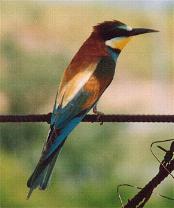
European bee-eater
 European bee-eater |
We go for regular walks in the fields and scrub areas on the edges of town, particularly on the Tetora hill, which is really in town, sometimes in the wild area to the west of Modi'in in the direction of the Ben Shemen forest and the Latrun reservoir south of the city. Common year-round residents of the Modi'in outskirts include the chukar partridge, cattle egrets, crested larks, blue rock thrushes, little owls, greenfinches, goldfinches, kestrels, blackbirds, barn owls and spur-winged plovers.
Perhaps our most dashing bird of the field is the blue rock thrush with his all blue plummage, going from a kind of cobalt blue on the head, upper body and belly through to a sort of blackish or navy blue on the tail and wings. In certain light conditions he looks almost black, though his shape and posture are quite different from that of the blackbird, which is becoming much more common in the area, attraced by the maturing gardens and parks.
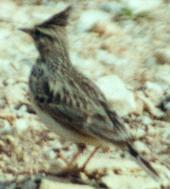 Crested Lark |
Crested larks are very common in Modi'in, especially in the many parks, building sites and other open areas in town. I often see them perched on rocks or hopping along the ground. I like the way that they call out in flight, a sort of 'wheeee' as though they are having such fun in the air that they just have let everyone know. I've also seen skylarks in the area.
I've also noticed many more birds on an overgrown strip of lands slated for development at some point, but meanwhile allowed to grow wild. While I haven't seen anything unusual it is fun to just go for a short walk from home and come across crested larks, several linnets, large flocks of Spanish sparrows, corn buntings, goldfinches, greenfinches and chaffinches.
Gold and Greenfinches are quite common in gardens and urban parks in Modi'in, but they are most common and in larger groups on the Tetora and in the area behind the Ligad shopping centre, and also in the fields near the neighbouring villages of Makkabim and Re'ut. As Modi'in's parks become more inviting, the finches have become more common in town as well. I've seen lots of As befits their Hebrew name hohit (thistle bird) I often see goldfinches perched atop the giant thistles which grow profusely in any open areas or unkempt gardens in the area, while greenfinches are more likely to be seen in trees.
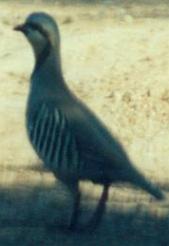 This Chukar didn't like the look of us |
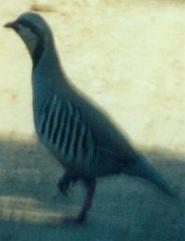 It hesitates... |
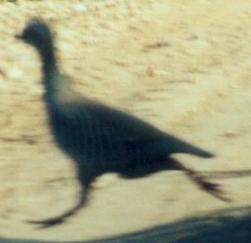 Is it a chukar or a road runner? |
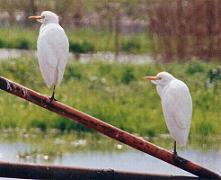 Cattle Egrets |
This medium sized partridge is in some parts of the country also a popular game bird and numbers have declined so much that there is now a moratorium on hunting them.
Cattle egrets,are a familiar site in the fields, grass verges and sometimes also gardens in and around the Modi'in area, and indeed in most of Israel. They are of course common near cattle, such as in the fields of neighbouring kibbutz Sha'alvaim, but they're certainly not limited to agricultural areas. They are social birds, which often roost together at night in trees, making the most unbearable racket. We often see them towards evening, flying in threes and fives towards their roosts.
When I say roost together, I mean together. One summer we were visiting friends in a village not far from here. That evening we heard the most terrible din, clucking, sqwawking and the like. We followed the noise and came across a copse of tall trees covered from top to bottom in cattle egrets perched on every available part of the tree, packed closely together and conducting what looked like an egret convention. I couldn't really see what type of trees they were, they looked more like cattle egret trees, shimmering white
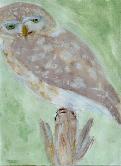 Little Owl |
There is a pair of little owls which used to live in Wadi Anaba, before they started "development work" on that area to turn it into a landscaped recreation park. When the work is finished maybe it will once again be a nice birding site, but for now it is a mess and the little owls which nested there several years in a row have moved elsewhere though I haven't located their new home. I certainly hear them in my own neighbourhood now, but I don't know whether it's the same pair.
I often see them perched on a lookout point of some sort, a lamp post, tree stump or seedlings. I've often seen little owls by day, usually towards the late afternoon or sometimes just around dusk. Their flight is eerily soundless, sometimes
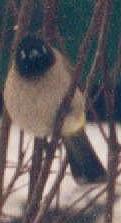 Bulbul in snow |
Barn owls are not as visible as little owls, but I've certainly heard their bloodcurdling screeches coming from the Tetora on several occasions, though I've never actually seen one in Modi'in itself, only in neighbouring villages such as Matityahu and Giva't Ehud, or on the Latrun-Modi'in road. Actually the clearest sightings that I've had of a barn owl have been of all places, a tree in the grounds of the Israel Museum in Jerusalem when the owl obligingly sat still in a tree so that I could get a good close look. Mostly I've just seen barn owls as ghostly pale shadows flitting across an open area between trees or buildings.
I think that there is at least one other type of owl in the area, because I've heard a distinct hooting at night, but I've never managed to track down the sound. I'm guessing that it was an eagle owl, but have yet to confirm this with an actual sighting.
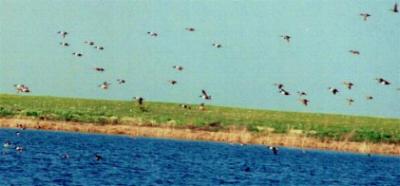 Ducks over Latrun Reservoir |
Just south of Modi'in is the Latrun reservoir. I've seen substantial flocks of shovelers, mallards, and a couple of ferruginous ducks. There may have been other ducks as well, but the last couple of tiems I visited a marsh harrier arrived on the scene, sending the ducks over to the far side of the reservoir. I also saw many coots and the usual spur winged plovers which are common in this region, either near water or agricultural areas. In the reeds I noticed a water pipit, and further along the water's edge a grey wagtail. The site is deceptively large, I've never really had enough time to spend there to thoroughly study it.
Year-round residents are joined throughout the year by seasonal visitors, some of whom spend the winter or summer in Israel and others who stop to rest on their long seasonal migrations. There is something thrilling about seeing the first birds of the new season, such as the black-eared wheatear, a summer resident whose arrival is a sure sign of spring, or the pied wagtail, whose arrival indicates that winter is on the way.
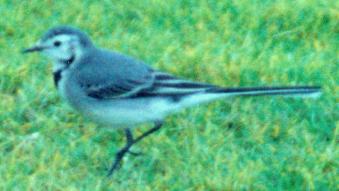 Pied wagtail |
In summer, certain visiting birds nest in the drainage pipes in the retaining walls of the buildings across the road from us, directly opposite the kitchen window in my old flat. Never was washing up such fun!Last year I enjoyed watching a pair of black-eared wheatears dart in and out of the pipes. The strikingly coloured black and white male liked to sit on the wall or a rock near its nest. Now I've seen them in the park across from my new home. Other summer visitors to the area include masked and woodchat shrike.
On the outskirts of Modi'in, where there are convenient embankments, European bee-eaters nest during the summer. They are the most colourful birds around, respendent in yellow, blues and browns, dashing around on their hunt for flying insects. A real treat to watch.
In recent winters I've noticed a lot more raptors in the area, buzzards, long-legged buzzards, hen harriers and black kites, species which previously I've seen occasionally around Modi'in but which I've been seeing more of.
The most exciting winter visitor for me is the imperial eagle I saw a few winters ago over the Tetora. I'd never seen such a large raptor right up close before and it was thrilling. I had stopped to photograph wild flowers when suddenly it rose up from behind a ridge only a few dozen metres from where I was standing and flew right overhead before disappearing over the other side of the hill. I was so awed by my proximity to the eagle that I forgot to photograph it even though for once I was actually close enough to get a clear shot, rather than some fuzzy picture of one soaring high overhead. I've since seen them a couple of times from a distance in the Modi'in area.
One of the most common overwintering birds in the area is the stonechat, which I've seen in pairs and in larger groups in open areas all around Modi'in, especially on the Tetora and in Wadi Anaba. I've also seen occasional hawfinches, Israel's largest seed eater, around Modi'in in winter. Other winter visitors include robins, black redstarts, chaffinches and chiffchaffs.
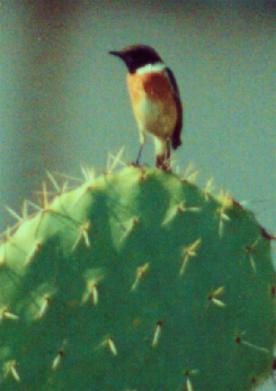 Male stonechat |
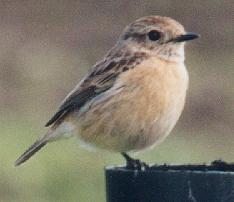 Female stonechat |
Many migrant birds pass though this area during the spring and autumn. Some of the most dramatic are the huge flocks of white storks which we often see during their spring migration. Two years ago hundreds of them rested in a field on the edge of the nearby Ben Shemen forest for a few days before continuing on their journey, and this year we saw an impressive 'flypast' over central Modi'in by scores of storks in the middle of the day. Once we also saw a large flock of white pelicans flying over one of Modi'in's main boulevards on their way north.
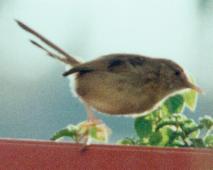 Graceful warbler |
There is a good selection of raptors passing through the area at migration time too, but unless you're out really early in the morning they are usually at such high altitudes that it's impossible to make out much detail. Easiest to spot and identify are the large groups of black kites we've often seen milling over fields in the area during the spring and autumn. I think that I may have also seen some honey buzzards this spring, but I couldn't see them clearly enough to be sure.
Short-toed eagles are one of the most common large raptors around here in summer, I've seen them over fields and by roadsides all over the area. These eagles are famous snake eaters, as their detonated by their Hebrew name, hivyay, derived from the Aramaic word for snake. Imagine my surprise then when I read an article in the paper about one just south of here which was constricted and killed by a large snake that it was trying to catch! The whole incident was caught on film and a still photo appeared in the paper. Quite a story. I haven't seen anything that dramatic, but it's still thrilling to watch one of these eagles catch a snake.
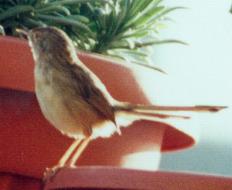 Graceful warbler |
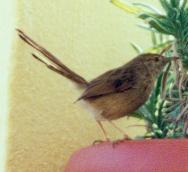 Graceful warbler |
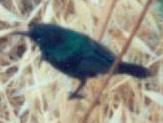 Male Sunbird |
Our balcony overlooks the gardens of the ground floor flats below, which attract many birds, including orange-turfted sunbirds, great-tits and various finches. The garden directly below us is wild and unkempt, but we don't really mind, because all the wildflowers, bushes, vines and weeds attract a large variety of birds, especially various types of warblers who like perching on bushes in dense undergrowth. Most of the warblers we see are graceful and Sardinian warblers, but we've noticed others too. During the spring and autumn I've also seen blackcaps there, and somtimes in winter chiffchaffs too, usually perched on the one large tree in the garden. The most commonly heard and seen birds in the 'jungle' below are the graceful warblers. Now the weeds are so high downstairs some of them are almost at the same level as our windows, so I've been seeing more of the warblers of late. Some of them also sometimes perch in the tall trees growing in other neighbouring gardens, so that also makes spotting them much easier, as some of these neighbouring trees are branching out in our direction.
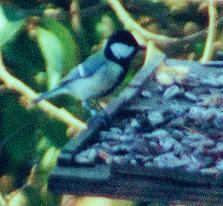 Great Tit |
Another typical garden bird which also frequents out balcony is the Tzufit - Hebrew for 'nectar bird' - or sunbird in English. It looks very much like a large hummingbird, with a long thin curved beak for drinking nectar with, though unlike the hummingbirds, it can't fly backwards. The male is dark, but iridescent, with flashes of metallic blues, greens and purple, and a tiny patch of orange and yellow, while the female is dull a olive-grey. I often see them darting around the gardens, and occasionally visiting balcony flowers too. They seem to be most attracted to our blue sage flowers, and to a lesser extent our morning glories, and they also like the passionfuit vine growing in one of the neighbouring gardens.
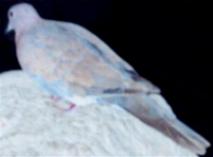 Palm dove |
Palm doves often frequent the local gardens, roof tops and sidewalks. This elegant looking dove is common throughout the region and often nest on balconies, roofs and on window shades. The main downside of having a palm dove (or any other dove) nesting on your shutters or balcony is that they tend to leave pigeon lice behind. Not pleasant. If you have a palm dove nesting outside your bedroom window they make pretty good alarm clocks, I can remember a pair waking me up regularly every morning between 5:30am and 6am with a gentle but persistant cooing. We've also seen the occasional collared dove in the area.
 Kestrel |
The cliff-like rectangular buildings of Modi'in are home to kestrels, which I often see soaring over our area or perching on a nearby roof ledge. I see kestrels all over Modi'in, and in most other parts of Israel, but the roofs of neaby buildings are the best places to see these birds up close. This roof ledge is at just the right angle for me to sit by my balcony or window and watch the kestrel, though of course, as with the other birds (and foxes)the kestrels have a rule that they only sit still in the same position when they know that I don't have a camera on hand or that it's the Sabbath or a festival when photography is forbidden. The above photo of a kestrel on a lamp post near my home is the best I have so far, though the kestrel moved to a closer perch as soon as it realised that I was out of film...
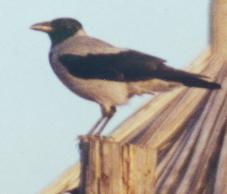 Hooded Crow |
Hooded crows are very common in most non-desert parts of Israel so it's no surprise to see them around Modi'in too, especially in the open areas and fields around the edge of town. I usually see them near Wadi Anaba or by the last row of buildings before the wadi, sometimes mobbing a kestrel, and once a buzzard.
Another bird which is incredibly common in Modi'in, and in most parts of Israel, is the yellow vented bulbul, a distinctly Middle Eastern bird. Many Israeli birders would say that this bird is too common, popping up in all kinds of places - just when you think you've spotted sommething interesting it turns out to be yet another bulbul!
I often see them perching in nearby trees or on buildings; sometimes they visit balconies too. They are very social birds, usually found in pairs, rarely alone, and they either sing beautifully or make a loud chattering noise that sounds as though all the neighbourhood gossips are having a convention.
Bulbuls are generally fruit eaters and now that one of our neighbours has a fig tree in their garden they are spending more time in easy view of our bedroom window, not to mention in easy earshot of our bedroom, allowing them to give us a chattering wake up call around 5am. I was concerned that the bulbuls would attack our balcony tomato plants, but after one dug its beak into an unripe cherry tomato and found it not to its liking they have steered well clear of our plants. I haven't actually located the nest, but our local pair raise a brood at least twice a year, though I only notice that they have chicks when the young have learnt to fly and I see the parents feeding them. Typically they have one to three fledglings.
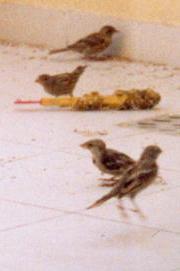 House sparrows on our balcony |
The easiest everyday way to watch birds is from our balcony. We sometimes leave out seeds or fruit for the birds, usually in a seed dispensing bird feeder. Sunbirds, graceful warblers, bulbuls, a few times also goldfinches, black redstarts and a jay, even occasional escaped budgerigars visit our balcony, but the most frequent visitors are house sparrows, which seem to be even more ubiquitous here than in Europe or anywhere else I've been.
Watching them daily on the balcony I confess that I've gained a new appreciation for these drab, extremely common birds. They are inquisitive about anything new on the balcony, and fast learners. I guess that explains why they are so good at adapting to living with people wherever they may be.
The sparrows are also great at controlling the insect population, they spend a lot of time picking bugs off our plants, without actually damaging the plants, even the most delicate flowers remain unharmed, even when the male decides that sitting on them is the ideal spot for catching some tasty insects.
Every laundry service porch in Modi'in is covered with some kind of latice work grate. I think of these as 'sparrow apartments' because every other grate seems to have a resident sparrow family. Our former apartment backs on to the back of another apartment building, with only a few metres between the two buildings. There is a pair of sparrows which nest in an airconditioning exhaust pipe in the grate immediately opposite our old balcony, and another pair which nest in a grate at the other end of the building. We often observed competition between these two sparrow families over who gets to feed at the balcony. I guess we're just naive romantics, but there is something very special about watching the adult birds (yes, even if they are only house sparrows!) feed their offspring, and Jason and I spend ages watching them.
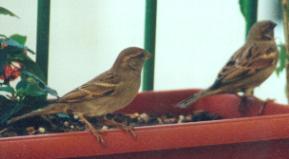 House sparrows on our balcony |
This is the only time when our plants are threatened by the sparrows, as the young birds are curious about everything. They taste every plant on our balcony, biting and tearing at leaves and flowers.
Birding intro |
Biblical birds |
Birdwatching links
Golan and Galilee |
Dead Sea and Ein Gedi |
Eilat and Negev
Jerusalem area |
Mediterranean coast |
Modiin area
Copyright 2004 by Leiah Elbaum. Text and illustrations on this page are by Leiah Elbaum. Last updated 9 June 2004.
Return to home